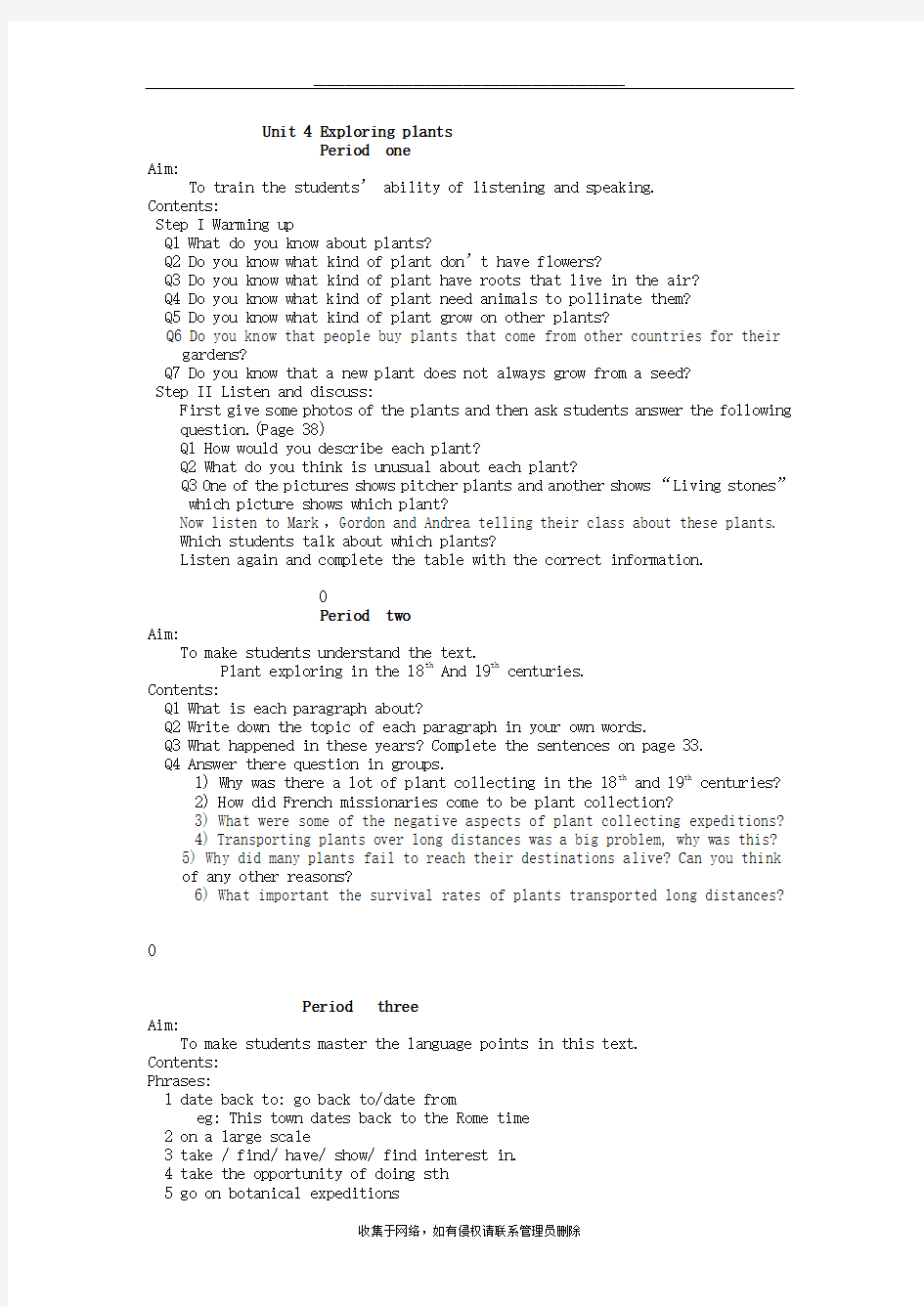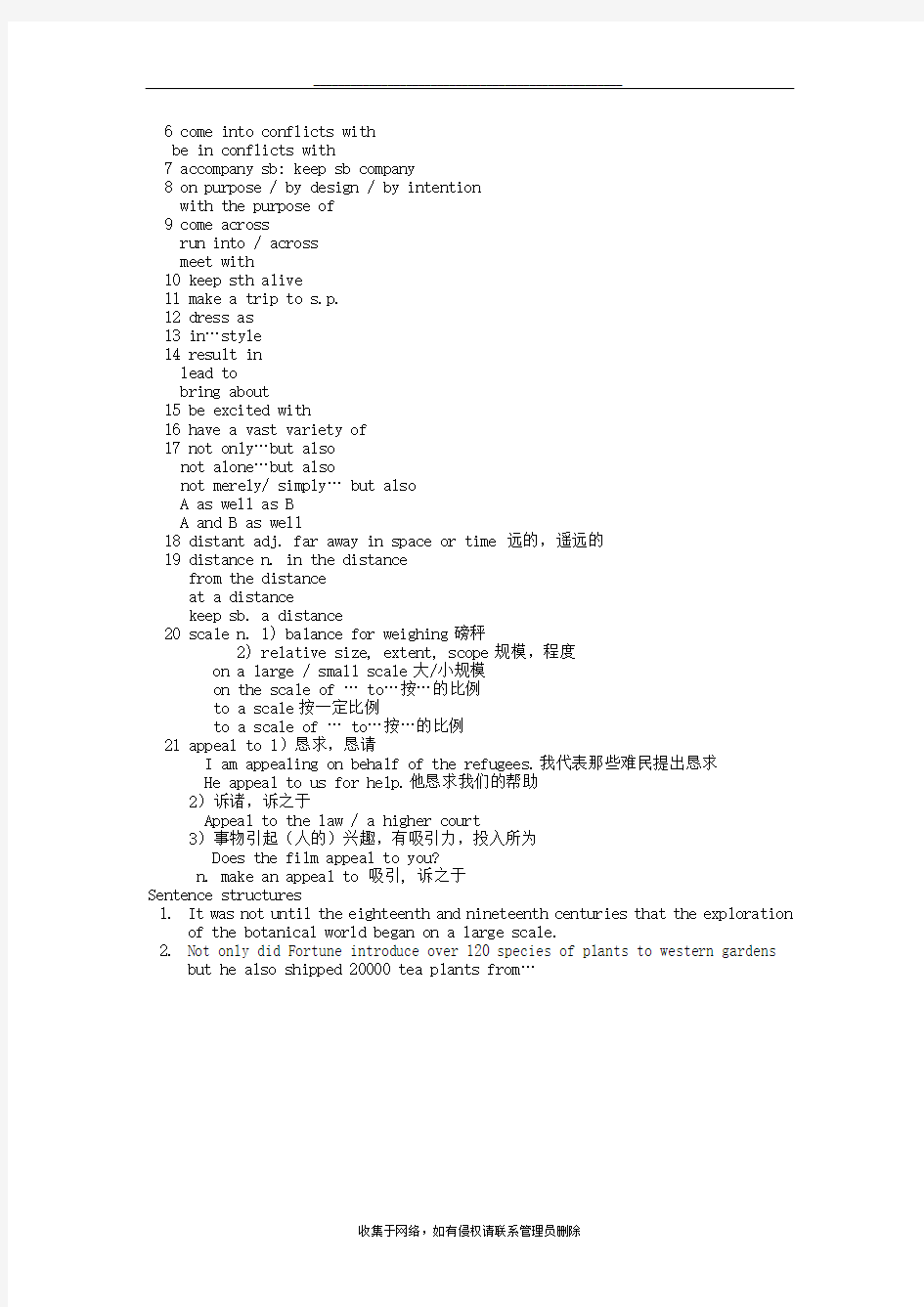

Unit 4 Exploring plants
Period one
Aim:
To train the students’ ability of listening and speaking.
Contents:
Step I Warming up
Q1 What do you know about plants?
Q2 Do you know what kind of plant don’t have flowers?
Q3 Do you know what kind of plant have roots that live in the air?
Q4 Do you know what kind of plant need animals to pollinate them?
Q5 Do you know what kind of plant grow on other plants?
Q6 Do you know that people buy plants that come from other countries for their gardens?
Q7 Do you know that a new plant does not always grow from a seed?
Step II Listen and discuss:
First give some photos of the plants and then ask students answer the following question.(Page 38)
Q1 How would you describe each plant?
Q2 What do you think is unusual about each plant?
Q3 One of the pictures shows pitcher plants and another shows “Living stones”
which picture shows which plant?
Now listen to Mark,Gordon and Andrea telling their class about these plants.
Which students talk about which plants?
Listen again and complete the table with the correct information.
Period two
Aim:
To make students understand the text.
Plant exploring in the 18th And 19th centuries.
Contents:
Q1 What is each paragraph about?
Q2 Write down the topic of each paragraph in your own words.
Q3 What happened in these years? Complete the sentences on page 33.
Q4 Answer there question in groups.
1) Why was there a lot of plant collecting in the 18th and 19th centuries?
2) How did French missionaries come to be plant collection?
3) What were some of the negative aspects of plant collecting expeditions?
4) Transporting plants over long distances was a big problem, why was this?
5) Why did many plants fail to reach their destinations alive? Can you think
of any other reasons?
6) What important the survival rates of plants transported long distances? 0
Period three
Aim:
To make students master the language points in this text.
Contents:
Phrases:
1 date back to: go back to/date from
eg: This town dates back to the Rome time
2 on a large scale
3 take / find/ have/ show/ find interest in.
4 take the opportunity of doing sth
5 go on botanical expeditions
6 come into conflicts with
be in conflicts with
7 accompany sb: keep sb company
8 on purpose / by design / by intention
with the purpose of
9 come across
run into / across
meet with
10 keep sth alive
11 make a trip to s.p.
12 dress as
13 in…style
14 result in
lead to
bring about
15 be excited with
16 have a vast variety of
17 not only…but also
not alone…but also
not merely/ simply… but also
A as well as B
A and
B as well
18 distant adj. far away in space or time 远的,遥远的
19 distance n. in the distance
from the distance
at a distance
keep sb. a distance
20 scale n. 1) balance for weighing磅秤
2) relative size, extent, scope规模,程度
on a large / small scale大/小规模
on the scale of … to…按…的比例
to a scale按一定比例
to a scale of … to…按…的比例
21 appeal to 1)恳求,恳请
I am appealing on behalf of the refugees.我代表那些难民提出恳求
He appeal to us for help.他恳求我们的帮助
2)诉诸,诉之于
Appeal to the law / a higher court
3)事物引起(人的)兴趣,有吸引力,投入所为
Does the film appeal to you?
n. make an appeal to 吸引, 诉之于
Sentence structures
1.It was not until the eighteenth and nineteenth centuries that the exploration
of the botanical world began on a large scale.
2.Not only did Fortune introduce over 120 species of plants to western gardens
but he also shipped 20000 tea plants from…
Period Four
Aim:
To make students understand the text
Flowers and their animal pollinators
Contents:
I. Questions:
1)What is the text about?
2)What do the pictures show you?
3)What is the chart about?
4)What is the advantage for animal of visiting flowers?
5)Who do some plants need animals?
6)How does an animal pollinate a flower?
7)What is nectar?
8)What kinds of animals are most flowers pollinated by?
II. Language points
1.over time 随着时间的推移
over the weekend 整个周末里
over these years 在这些年里
2.reward sb with sth用…回报某人
3.attach… to依附于…上
4.pass on to把…往下传
5.adapt to 使…适应
The spokesman adapts his speech to suit the interests of his audience.
He has adapted to the climate here.
6.describe … as 把…描述成
7.guide sb to s.p.把…领到…
https://www.doczj.com/doc/5817712921.html,nd on 登陆
9.provide sb. with sth向…提供
provide sth for sb.
provide for 养活,规定
III. Difficult sentences
1)Pollen becomes attached to the animals during its visit to a flower and is then
passed on to another plant’s blossom on its next visit.动物接触一朵花后,花粉就附着在它身上,动物接触下一种植物的花时就把这些花粉传到花朵上.
2)Through evolution, most flowers have become adapted to attract specific types
of pollinators.通过进化,大部分花朵变得适于吸引特殊种类的花粉传播者.
四、排序不等式
(一)概念【9】:
设有两组实数
n a a a ,,
,???21 (1) n b b b ,,
,???21 (2) 满足
n a a a ≤???≤≤21 (3)
n b b b ≤???≤≤21 (4)
另设
n c c c ,21???,
, (5) 是实数组(2)的一个排列,记
逆序积和1121b a b a b a S n n n +++=-
乱序积和n n c a c a c a S +++=2211'
似序积和n n b a b a b a S +???++=2211''
那么
'''S S S ≤≤
且等式成立当且仅当
n a a a =???==21
或者
n b b b =???==21
证明【9】:
1,预备知识
引理1(Abel 变换) 设(1)(2)为任意两组有序的实数组,令
,010∑==
=k
i i k b B B , 那么
k n k n k k k n n k k B a a B a b a ∑∑=-=---=1111)(
事实上:
=-=∑∑==-n k n
k k k k k k B B a b a 111)(112111)()(B a B B a B B a n n n n n n +???+-+-----
-???-----=-------)()(2221111n n n n n n n n n n B a B a B a B a B a 112)(B a a -
∑-=---=1
11)(n k k k k n n B a a B a
引理2 设实数组(2)满足(4)式,实数组(5)是实数组(2)的任意一个排列,那么显然有
∑∑∑=+-==≤≤k i i n k i i k i i b c b 1111 引理3 设实数组(2)满足(4),那么